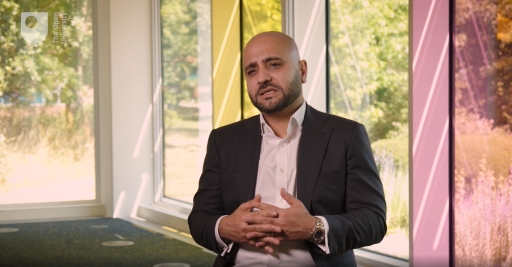2.2 Interviews and assessment centres
Traditionally, employers have seen the interview as an opportunity to assess whether a candidate will fit well within their organisation. But in this short film, Asif Sadiq explains that rather than looking for ‘cultural fit’ among your interviewees, you should be looking for ‘cultural add’.

Transcript: Video 4: Diversity in recruitments
Interviews
Another way to look at this is through the lens of unconscious bias. You learned about unconscious bias in Week 4, now watch this short video from Liz Kingston, who talks about the three most common unconscious biases that can affect us when we are interviewing.
Preparation is key to conducting a fair and inclusive interview – including creating an appropriate panel of diverse interviewers, ensuring you ask each candidate the same questions and developing a shared scoring system.
Law firm, Clifford Chance conducts what it calls ‘CV blind’ interviews, which means that the interviewers know nothing about the candidate before they enter the interview space.
To further signal your commitment to diversity and inclusion, you might choose to ask a question about it during the interviews you conduct. Garrison (2024) makes the following suggestions:
- What do inclusion and diversity mean to you?
- How do you approach understanding your team-mates who are from different backgrounds?
- How would you promote diversity and inclusion in the workplace?
- How do you educate yourself on issues relating to diversity and inclusion?
A focus on strengths-based interview questions is a good way to assess future potential rather than previous experience. This more inclusive approach doesn’t discriminate against those who may not have been able to access relevant work experience, for example due to caring responsibilities or issues of social inequality. Swain (2025) provides examples of strengths-based interview questions, including:
- What energises you?
- Do you most like starting tasks or finishing them?
- Describe a successful day. What made it successful?
- What do you enjoy doing the least?
- What tasks are always left on your to-do list?
- Have you ever done something differently the second time around?
Rinderknecht (2021) describes the benefits of sharing interview questions with candidates before the interview. These include:
- Creating a level playing field.
- Reducing a candidate’s stress.
- Helping the candidate understand what you are looking for.
- Generating more thoughtful answers.
This approach can benefit a wide variety of candidates in different ways. For example, it gives neurodiverse candidates time to prepare and the opportunity to present their thoughts in an ordered way; where English isn’t a candidate’s first language, it gives them the chance to plan and articulate what they want to say; introverts who find it difficult to ‘sell’ themselves will have time to present their answers in a more authentic way.
Interviewers report that the conversation flows more, making it easier to have meaningful conversations about a candidate’s experience and strengths.
Due to the nature of its work, British intelligence agency GCHQ (Izundu, 2020) recruits a large number of neurodivergent individuals. As a result, it has significant experience of appropriate support mechanisms during the recruitment process and beyond.
For example, during recruitment, they have implemented the following adjustments:
- allowing candidates to take notes and mind maps into interview
- providing extra time to compensate for slower processing speed
- not asking multiple questions at the same time
- using a whiteboard or flipchart to ‘car park’ questions to return to later.
Video interviews
While video interviews were already in existence, the pandemic has certainly increased their prevalence, with many organisations now choosing to use them.
Shine (no date) has the following advice to ensure that the process is as inclusive as possible:
- Keep your applicants informed – let them know in advance it will be a video interview, and advise them on how to ensure their tech set-up is suitable (you don’t want them to drop out because their technology isn’t at a high enough spec)
- Make sure you provide alternative options in case the technology goes wrong – for example, the opportunity to continue the interview by phone
- Make your candidate feel comfortable – reassure them that their performance won’t be jeopardised if there is some form of external disruption; if internet bandwidth is a challenge, suggest that after initial introductions cameras could be turned off and then on again at the end of the interview to round up
- Let the candidate know they can stop the interview and ask questions if something seems amiss and that this won’t affect their application.
Reasonable adjustments to interviews
A candidate with a disability can ask for changes to job interviews and associated tests to ensure that they are not disadvantaged.
One way to encourage this would be to ask about it in your interview invitation correspondence. Creative Diversity Network suggests the following approach,
‘Do you require any adjustments because of a disability?’, followed by an offer to answer any questions the applicant has about the interview process to help them work out if they need to ask you for anything. This is also an opportunity to be clear about whether the interview will take place in a building with level access and if a hearing loop is available.
Giving the candidate a sense that this won’t be a problem for you reinforces the inclusivity of your working environment.
Many employers include a question about adjustments on the application form, but Creative Diversity Network (no date) recommends that you don’t do this, as it will be better to keep this information separate to the application in order to avoid any suggestion of discrimination later on.
Activity 4 Learning from the experience of others
Watch this video case study from Marshall E-learning Consultancy. In it, some staff within a university are shortlisting candidates for interview.

Transcript: Video 6: How to Get Inclusive Recruitment and Selection Right
What can you take away from this film? Is there anything you could introduce into your own processes and procedures?
Comment
Taking a more structured approach with a scoring system and a diverse panel of assessors, will enhance the fairness of the process. The scoring system also allows assessors to pause and recognise their own potential biases when they arise.
Assessment centres
Assessment centres are often used in graduate recruitment or for management roles. An assessment centre is a collection of tests and activities designed to simulate the working environment and to test a candidate’s abilities and potential.
Common activities include group discussions, in-tray exercises, presentations and case studies.
There are many ways in which some of the activities might not be seen as inclusive. For example, an individual with autism may find a group discussion difficult. Equal Engineers (2020) suggest a couple of ways to support this:
- offer those with autism spectrum disorder (ASD) the chance to write their ideas down during the group session and to submit them at the end
- ask for every individual’s ideas one by one during the exercise.
These could be useful tactics for any group discussion, supporting candidates who have a more introverted preference and who may be feeling overwhelmed by the process.
Some employers have taken away the timed element from the assessment activities, or removed group exercises altogether. Others have introduced support prior to the assessment centre for under-represented candidates.
Social work charity, Frontline (Frontline, no date)
Over the past five years, Frontline has increased the percentage of racialised ethnic minority participants on the cohort from 15% to 26%. To do this, they have implemented the following initiatives:
- working with focus groups of professionals to ensure that their application process supports applicants from disadvantaged backgrounds, including racialised minority groups.
- expanding eligibility criteria to widen participation among underrepresented and disadvantaged groups.
- offering contextual recruitment for applicants in underrepresented groups to allow equitable opportunities in the selection process.
- offering additional support to applicants from underrepresented groups during each stage of the application process, including 1:1 coaching and exclusive online webinars.
- employing a diverse team of assessors to ensure different voices and perspectives are considered when assessing an applicant.
Once you’ve recruited someone to a post, the next crucial stage in successfully communicating your diversity and inclusion agenda is effective onboarding, and you’ll look at that in the next section.
